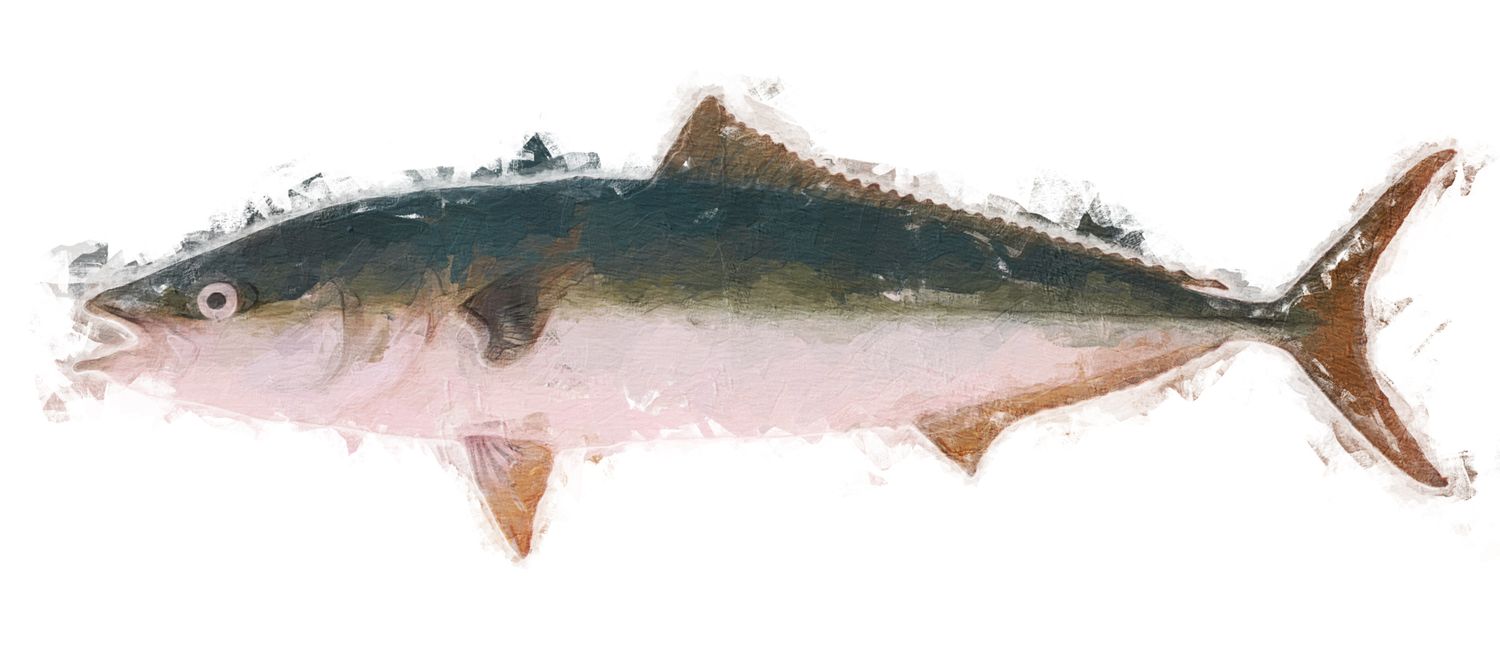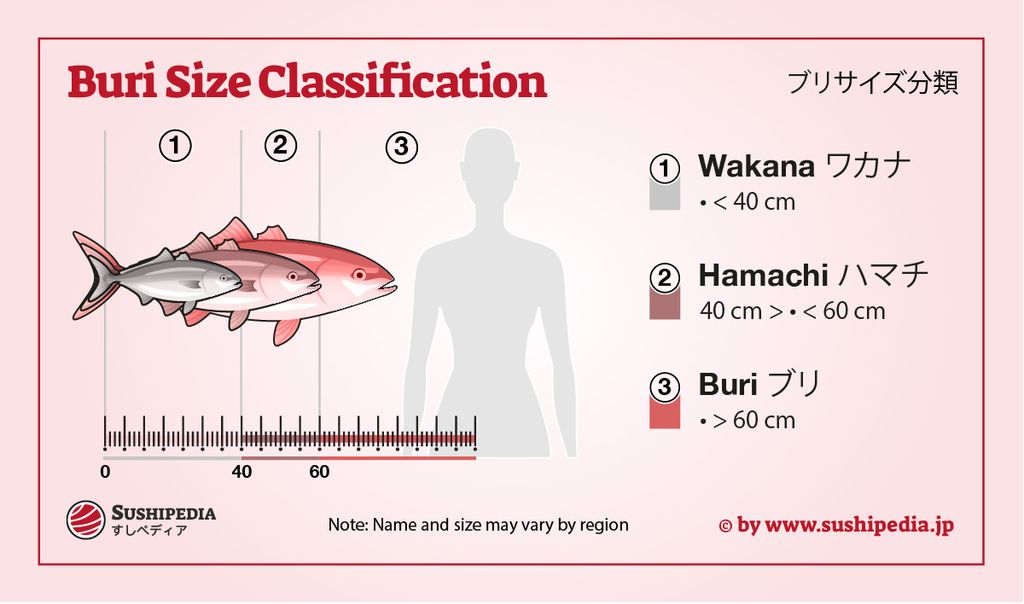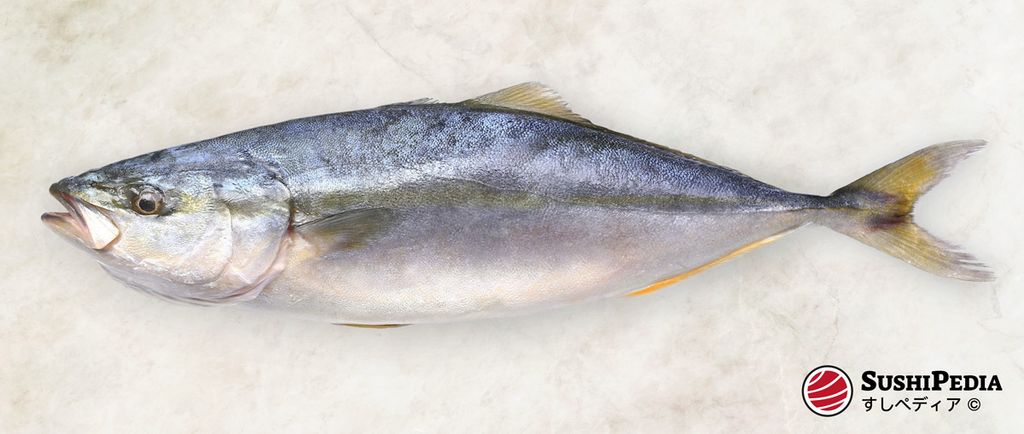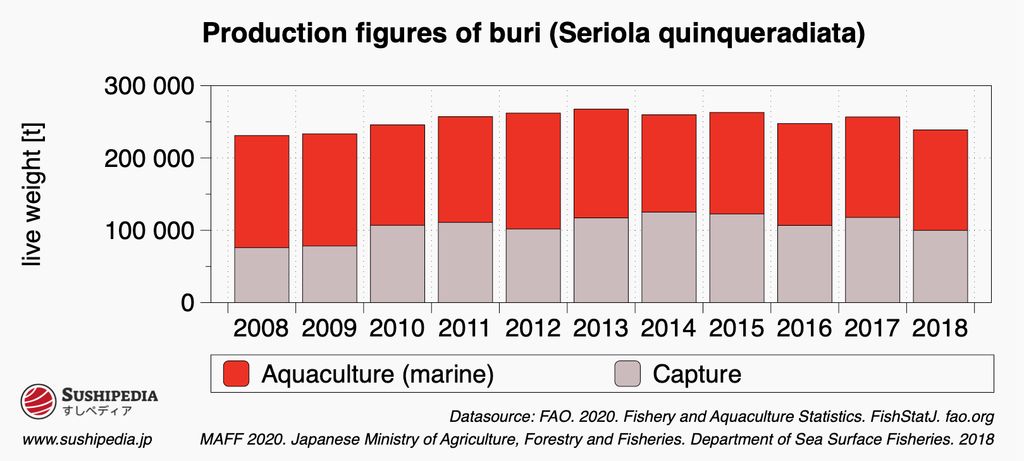Buri Sushi
A Comprehensive Overview of Japanese Amberjack in Japanese Sushi Cuisine
ブリすし 、 鰤寿司 
What is Buri?
In Japanese nomenclature, the Japanese amberjack or yellowtail (Seriola quinqueradiata) is generally referred to as buri 鰤. In the gastronomic and vernacular context, however, the term refers to adult or fully-grown specimens of this fish species. This contrasts with the term hamachi ハマチ, which refers to the younger, not yet fully grown fish of the same species. Japanese yellowtail mackerel bred in aquaculture in particular are often referred to as hamachi because they are harvested before reaching their maximum body size. The differentiation between buri and hamachi highlights significant differences in age and size, which is also reflected in a graded flavor profile and a different texture of the meat.
Buri for Sushi or Sashimi
The flavor of buri is intense and accompanied by subtle sour aromas. The meat is medium-firm and has a full-bodied buttery flavor. Because of the high fat content, soy sauce does not stick well to the surface. Japanese horseradish (wasabi 山葵) or grated winter radish (daikon 大根) pairs better as garnish.
In contrast to a young buri, which is called hamachi, the meat of buri is darker and more reddish in appearance. The meat of hamachi, on the other hand, is light, pink, and slightly translucent. Individuals from aquaculture have a significantly higher fat content than those from the wild.
Best Season
When caught wild, the best season begins in early winter and ends at the beginning of spring. During this time, the fish migrate south and gain fat. During this season, the fish are also called “cold” or “winter buri” (kan buri 寒ブリ). Important fishing areas at this time are the Japanese sea and the Pacific.
Since buri is increasingly farmed, it is available from aquaculture all year round in constant quality. Farmed buri are nowadays mostly referred to as hamachi.
Is Buri White or Red Meat?
Occasionally, buri is categorized as a white fish (shiromi sakana 白身魚), although it is actually a fish with red meat (akami sakana 赤身魚). Whitefish are mostly coastal groundfish and prefer flat, sandy or rocky habitats. In contrast to red-fleshed fish, which prefer the open sea, they only travel short distances and require less oxygen for muscle supply. Their body is therefore less muscular and is predominantly made up of white muscle fibers. Responsible for the red coloration of muscles is myoglobin, which serves to transport oxygen into the cells. However, the meat of a buri is so heavily interspersed with fat that it appears visibly brighter and can therefore deceive one into thinking that it is not a fish with actually red meat.
Buri in Japan
Buri enjoys a special place in Japanese cuisine. It is especially prized in the Kansai and Hokuriku regions and is considered an important ingredient in celebrations such as the New Year.[1] The three largest fishing grounds in Japan are located in Himi City in Toyama Prefecture, on the Goto Islands in Nagasaki Prefecture and in Ine in Kyoto Prefecture. During summer, the fish mainly stay around Hokkaido and then migrate to the Sea of Japan in late fall when the temperatures drop.[2]
Himi Kan Buri: A winter delicacy from the icy waters of Toyama
The town of Himi, located in Toyama Prefecture on the coast of the Sea of Japan, enjoys an excellent reputation for its fishing industry, especially for catching buri. The name Himi, which literally means “view of ice” in the characters 氷見, may reflect the cold, clear waters that surround this region and provide ideal conditions for buri habitat. It is this combination of geographical location and the natural ocean currents that gives the buri caught in Himi its excellent taste and high quality.
Especially in winter, when the water temperatures drop, the buri from Himi, known as Himi Kan Buri ひみ寒ブリ, reaches its peak of flavor and fat content. Kan stands for cold, which refers to the season in which this fish is caught. Buri, which are caught during this time and weigh more than 10 kilograms, are known for their rich, oily taste, which makes them a delicacy that is appreciated far beyond the borders of Toyama Prefecture. The high fat content, especially in the colder months, provides a deep, rich flavor that makes it a favorite for sushi, sashimi, and other traditional Japanese dishes.
So if you are visiting the Toyama region in winter, make a stop in Himi and try Himi Kan Buri in one of the local restaurants.
A Fish That Changes Its Name

SushiPedia. Buri Size Classification Chart. All rights reserved ©
Buri is a fish whose name changes as it grows (shusseuo 出世魚). The names used, especially for juveniles, vary considerably depending on the region and size, particularly in the sport fishing environment. Regardless of ichthyology and regional preferences, the names “wakana” for young, “hamachi” for medium-sized and “buri” for large specimens are familiar to chefs in sushi gastronomy.
The following table gives a more specific overview of the regional names during the growth process:
| Region | Names |
|---|---|
| Hiroshima | yazu → hamachi → buri |
| Hokuriku | tsubaeri → kozukura → fukuragi → aoburi → hanajiro → buri |
| Kansai | yazu → hamachi → mejiro → buri |
| Kanto | wakashi → inada → warasa → buri |
| Kyushu | wakanago → yazu → hamachi → mejiro → buri → oouo |
| Nagano | inada → hamachi → buri |
| Sanin | shoujigo → wakana → mejiro → hamachi → buri |
| Shikoku | yazu → hamachi → buri |
| Shimokita | fukuragi → inada → warasa → buri |
| Tohoku | tsube → inada → ao → buri |
| Toyama | tsubaiso → kozukura → fukuragi → gando → buri |
| Yamaguchi | yazu → hamachi → buri |
Etymology
According to the book Genkai 言海, an old Japanese dictionary, the word “buri” was derived from abura 油 (oily).
Characteristics & Ecology of Buri

Unknown author. Buri: A Winter Delight in Sushi Cuisine. All rights reserved ©
Buri is a swarm-forming predatory fish that feeds mainly on smaller fish, squid, or crustaceans. A striking feature is its lateral yellow band that runs along its blue back from head to tail. The usual length of buri is about 100 cm (ca. 39 inch) with a weight between 5 and 7 kg (11–15 lb). With their long and strong body, they can reach speeds of over 50 kilometers per hour (ca. 31 mph). Their distribution extends mainly along the Japanese archipelago across the Pacific Ocean to Hawaii. Buri is migratory and moves southwards into warmer waters during the winter.
Buri vs. Kanpachi vs. Hiramasa
In Japan, a distinction is primarily made between three species within the genus Seriola: Buri, kanpachi and hiramasa. Although all three species are characterized by a distinctive yellow band along the body, it can be challenging for non-professionals to distinguish between them due to their external appearance. This similarity occasionally leads to one of the fish being used as a substitute for another, whether consciously or unconsciously. Interestingly, the combined catch and production volumes of kanpachi and hiramasa account for only about 5% of the total, underlining the dominance of buri in Japan's fisheries and aquaculture. This information illustrates not only the ecological and economic importance of buri, but also the specialized niche that kanpachi and hiramasa occupy in the gastronomy sector.
Economy of Buri

SushiPedia. Production Figures for Buri (Seriola quinqueradiata) from 2008 to 2018. All rights reserved ©
In the period from 2008 to 2018, the catch and production figures for buri show significant stability. This indicates that the fishing industry has found a balance between wild-caught and aquaculture yields that meets consumer demand. The data presented in the graph, with a separation between aquaculture (red) and wild capture (gray), shows that aquaculture makes the larger contribution to overall production. Nevertheless, wild capture remains an important component of the overall figures and does not show any significant declines.
Interestingly, the consistency of overall production could also indicate a plateau in market demand. In a world where overfishing and environmental concerns are becoming more prominent, this could be a sign that the industry is trending towards more sustainable practices. It may also reflect an increasing consumer preference for aquaculture products.
Season Calendar for Buri
The calendar shown does not provide information on fishing times, but marks the periods in which buri is considered particularly tasty.
Warnings related to Buri
Video about Buri Sushi
External video embedded from: youTube.com. Credit 鮨リズム / SUSHI RHYTHM. 【寿司】自宅で鮨を握る【ブリの漬け(柵から簡単に仕込み)】(字幕補足あり).
Species of Buri
The following species are regarded as authentic buri. Either historically, according to the area of distribution or according to the common practice in today's gastronomy:
Sources and Further Reading
- [1]『民俗民芸双書』. 岩崎美術社. 1966
- [2]Japanese Yellowtail(November-February). Ine Tourist Information. Source retrieved 12/30/2023
- [3]Fish and Fishery Products Hazards and Controls Guidance. U.S. Department of Health and Human Services Food and Drug Administration Center for Food Safety and Applied Nutrition. 2020
- Rainer Froese, Pauly Daniel. FishBase. The Leibniz Institute of Marine Sciences at the University of Kiel, FishBase.org, 2019. Source retrieved 12/24/2020
- Seafood Watch, Consulting Researcher. Yellowtail, Seriola spp., Japan, Marine Net Pens, Aquaculture Standard Version A2. Monterey Bay Aquarium, Monterey. 2016. Source retrieved 12/24/2020
- 昌髙藤原. 『ぼうずコンニャクの市場魚貝類図鑑 (Bozu Konyaku's Market Fish and Shellfish Book)』. Bozu Konnyaku Co., Ltd., Tokyo ぼうずコンニャク株式会社東京, zukan-bouz.com、 2020. Source retrieved 12/27/2021
- IUCN Red List of Threatened Species. Version 2023-1
Image Credits
- Unknown author. Buri: A Winter Delight in Sushi Cuisine. All rights reserved ©
- SushiPedia. Buri Size Classification Chart. All rights reserved ©
- SushiPedia. Buri Sushi. All rights reserved ©
- SushiPedia. Production Figures for Buri (Seriola quinqueradiata) from 2008 to 2018. All rights reserved ©
- SushiPedia. Buri Size Classification Chart. All rights reserved ©